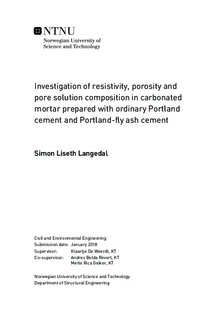Investigation of resistivity, porosity and pore solution composition in carbonated mortar prepared with ordinary Portland cement and Portland-fly ash cement
Master thesis
Permanent lenke
http://hdl.handle.net/11250/2488746Utgivelsesdato
2018Metadata
Vis full innførselSamlinger
Sammendrag
This project investigated how carbonation affected resistivity in mortars made with different cement types. The goal was to explain this by investigating the pore solution composition, the pore structure and the moisture content in mortars made with different cements and exposed to different relative humidity and CO2-concentrations. Mortar samples made with CEM I and CEM II/B-V were cured for 14 days and exposed to CO2 for 27 weeks before testing. The resistivity was measured using embedded titanium bars in the mortar samples. The pore structure was investigated using the PF-method. The extent of carbonation was measured using thermogravimetric analysis. The pore solution composition was investigated with cold water extraction and pore solution expression followed by analysis by ICP-MS. The impact of carbonation in the different RH-conditions could not be concluded, as the mortars stored at 90% RH and 5% CO2 had not fully carbonated within the course of the project. Carbonation caused the resistivity to increase drastically for both cement types. The resistivity of mortars made with CEM II/B-V were found to be higher than that of mortars made with CEM I, both in carbonated and non-carbonated state, but the ratio between the two cements could indicate that carbonation may have a bigger impact on the resistivity than the type of cement has. Carbonation decreased the moisture content and pore volume in the mortars from both cement types. The mortars made with CEM II/B-V showed a larger pore volume than mortars made with CEM I in all exposure conditions. The degree of capillary saturation was found to be related to resistivity, as a lower degree of saturation corresponded to a higher resistivity. The pore solution composition also changed upon carbonation. A significant drop in the concentration of Na and K was seen upon carbonation. In the non-carbonated samples, the samples from CEM I showed a higher content of Na and K compared to samples from CEM II/B-V, whereas the Na and K content was similar for both cement types after carbonation.
Both moisture content, degree of capillary saturation and pore solution composition appears to influence the resistivity, but it was not possible to conclude to which extent each parameter influenced the resistivity.
